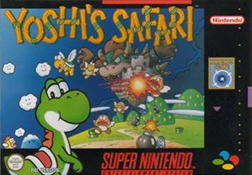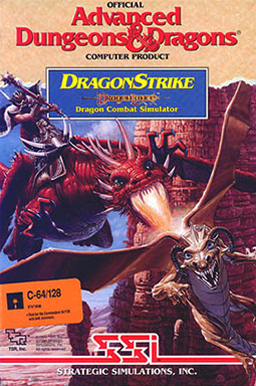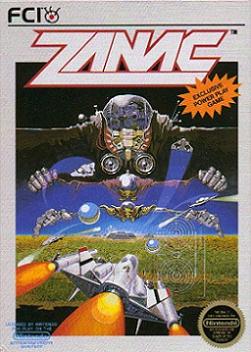
Yoshi's Safari is a 1993 light gun shooter developed and published by Nintendo for its Super Nintendo Entertainment System (SNES). It is the only Mario franchise game to feature first-person shooter gameplay and requires the SNES's Super Scope light gun. As Mario and his pet dinosaur Yoshi, the player embarks on a quest to save the kingdom of Jewelry Land from Bowser and his Koopalings, who have kidnapped its rulers and stolen 12 gems. The game features 12 levels in which the player shoots enemies like Goombas and Koopas, and collects power-ups and coins. At the end of each level, the player engages in a boss fight with an enemy, a Koopaling, or Bowser. Nintendo commissioned its R&D1 department to develop Yoshi's Safari in response to the waning popularity of the Super Scope. Yoshi's Safari was the first Super Scope title to use the SNES's Mode 7 graphics mode, and the future of the peripheral depended on the game's performance.
Ninja Gaiden is a media franchise based on action video games by Tecmo featuring the ninja Ryu Hayabusa as its protagonist. The series was originally known as Ninja Ryukenden in Japan. The word "gaiden" in the North American Ninja Gaiden title means "side story" in Japanese. The original arcade version, first two Nintendo Entertainment System games and Game Boy game were released as Shadow Warriors in PAL regions. As of 2008, the series has shipped over 7.7 million copies.

DragonStrike is a 1990 flight simulator based on the Dungeons & Dragons fantasy tabletop role-playing game. It is set in the Dragonlance campaign setting.

Ninja Gaiden II: The Dark Sword of Chaos, known in Europe as Shadow Warriors II: The Dark Sword of Chaos, is a 1990 action-platform game developed and published by Tecmo for the Nintendo Entertainment System. It is the second installment in the Ninja Gaiden trilogy for the NES and was released in North America and Japan in 1990, and in Europe in 1992. An arcade video game version was also introduced by Nintendo for their PlayChoice-10 system in 1990.
A cooperative video game, often abbreviated as co-op, is a video game that allows players to work together as teammates, usually against one or more non-player character opponents (PvE). Co-op games can be played locally using one or multiple input controllers or over a network via local area networks, wide area networks, or the Internet.

Zanac (ザナック) is a shoot 'em up video game developed by Compile and published in Japan by Pony Canyon and in North America by FCI. It was released for the MSX computer, the Family Computer Disk System, the Nintendo Entertainment System, and for the Virtual Console. It was reworked for the MSX2 computer as Zanac EX and for the PlayStation as Zanac X Zanac. Players fly a lone starfighter, dubbed the AFX-6502 Zanac, through twelve levels; their goal is to destroy the System—a part-organic, part-mechanical entity bent on destroying mankind.

Battle Clash is a 1992 light gun shooter video game developed by Intelligent Systems and published by Nintendo for the Super Nintendo Entertainment System. It is one of several titles that requires the Super Scope light gun. Set in a futuristic post-apocalyptic Earth where battles are fought with mechs called Standing Tanks (STs), a man named Mike Anderson participates in the Battle Game to face the ruthless champion Anubis. The player acts as the gunner of the ST Falcon piloted by Anderson, taking on Anubis and his subordinate chiefs in one-on-one fights.

Resident Evil Outbreak: File #2 is a survival horror video game developed and published by Capcom with online playability for the PlayStation 2. It is the sequel to Resident Evil Outbreak, and the final installment of the spin-off series. It was released on September 9, 2004 in Japan, on April 26, 2005 in North America, and August 26, 2005 in PAL regions.

Dangun Feveron is a 1998 vertical-scrolling shooter arcade game developed by Cave and published by Nihon System in Japan. Players control a fighter craft and must destroy waves of enemies throughout a series of scrolling stages that increase in difficulty. The game's scoring system is designed to encourage players to destroy as many enemies possible, as points are subtracted based on how many enemies leave the screen. It is known for its elaborate disco-inspired presentation, soundtrack, and sassy voiceovers.

Challenger is an action-platform video game developed and published by Hudson Soft for the Famicom in 1985.

Dragon Spirit is a 1987 vertical-scrolling shooter arcade game developed and published by Namco. In North America, it was distributed by Atari Games. Controlling the dragon Amur, the player must complete each of the game's nine areas to rescue the princess Alicia from the demon Zawell. Similar to Namco's own Xevious, Amur has a projectile weapon for destroying air-based enemies and a bomb for destroying ground enemies. It ran on the Namco System 1 arcade board.

Dragon Saber: After Story of Dragon Spirit is a 1990 vertical-scrolling shooter arcade game developed and published by Namco. It is a sequel to Dragon Spirit, released in 1987.

Radirgy is a shoot 'em up video game developed by MileStone Inc. and released for the Sega NAOMI arcade platform in 2005. The story follows schoolgirl Shizuru Kamigusa in an age filled with radio waves which she is allergic to. She must save her father, who is developing a remedy for her sickness, from terrorists who have taken control of his company. The game features bullet hell gameplay elements and a distinct cel shaded graphical style.

Advanced Dungeons & Dragons: Treasure of Tarmin is a video game for the Intellivision video game console and the Mattel Aquarius computer system. This game was a licensed Dungeons & Dragons adaptation. It is a successor game to Advanced Dungeons & Dragons: Cloudy Mountain (1982).

Rise of the Kasai is an action-adventure game developed by BottleRocket Entertainment and published by Sony Computer Entertainment America exclusively for PlayStation 2. The game serves as a followup to the 2002 action-adventure game The Mark of Kri.
Little Fighter 2 is a Hong Kong freeware PC fighting game for Windows and is the sequel to the game Little Fighter. Little Fighter 2 was created by Marti Wong and Starsky Wong in 1999, and received a long series of updates.

Resident Evil 6 is a 2012 third-person shooter video game developed and published by Capcom. A major installment in the Resident Evil series, Resident Evil 6 was released for the PlayStation 3 and Xbox 360 in October 2012, and for Windows in March 2013. It was re-released with all downloadable content for the PlayStation 4 and Xbox One in March 2016, and for the Nintendo Switch in October 2019. Players control Leon S. Kennedy, Chris Redfield, Jake Muller and Ada Wong as they confront the force behind a worldwide bio-terrorist attack. The story is centred around their four interwoven campaigns, and every campaign features a unique style in both tone and gameplay.

Don't Look Back is a platform game playable through Adobe Flash and designed by Terry Cavanagh. The game is a modern interpretation of the Greek legend of Orpheus and Eurydice.

Tom Clancy's Rainbow Six: Shadow Vanguard is a 2011 first-person shooter video game developed and published by Gameloft for iOS, Xperia Play and Android devices. The game is a remake of the original Tom Clancy's Rainbow Six video game.
Since the origin of video games in the early 1970s, the video game industry, the players, and surrounding culture have spawned a wide range of technical and slang terms.

















